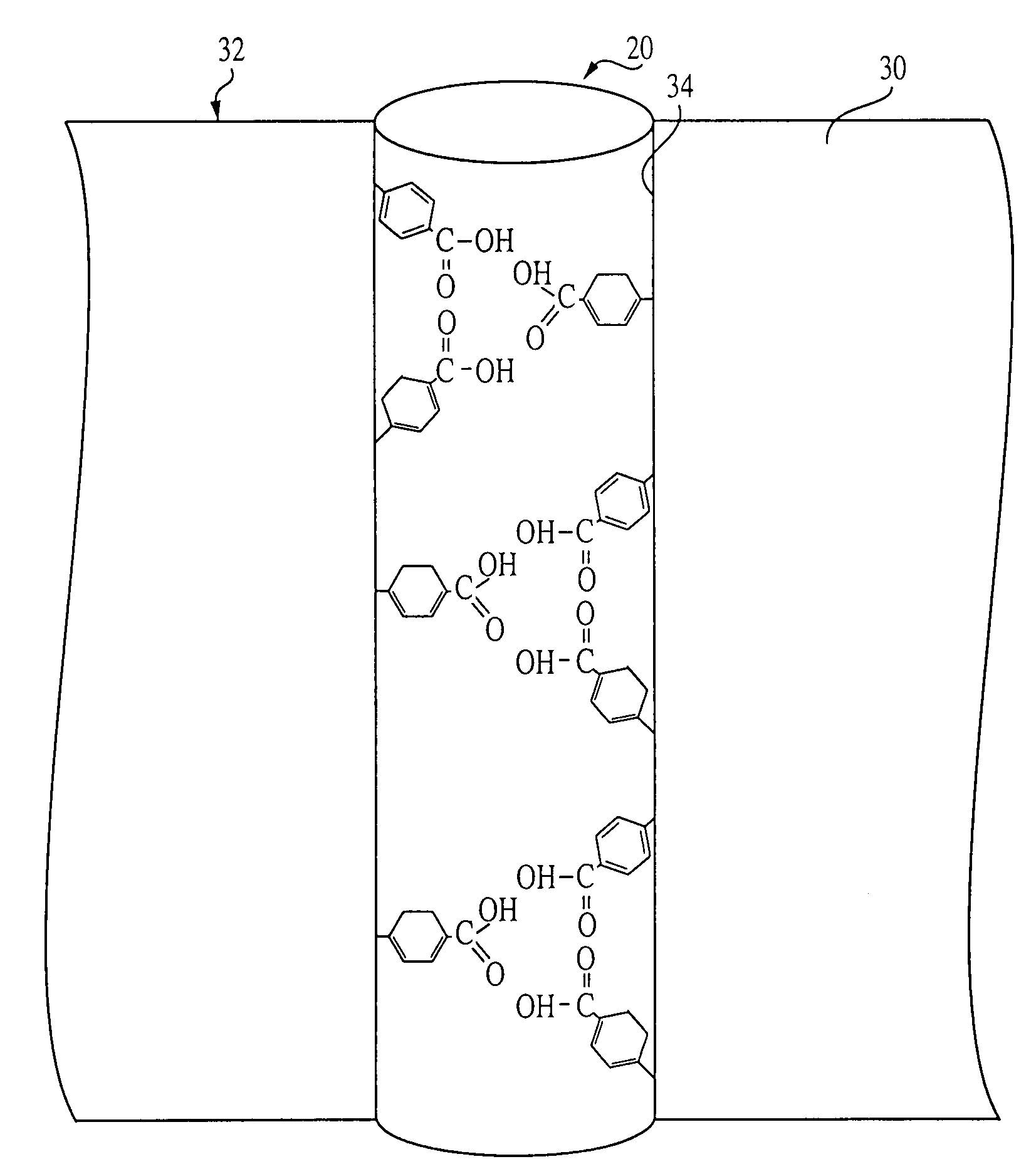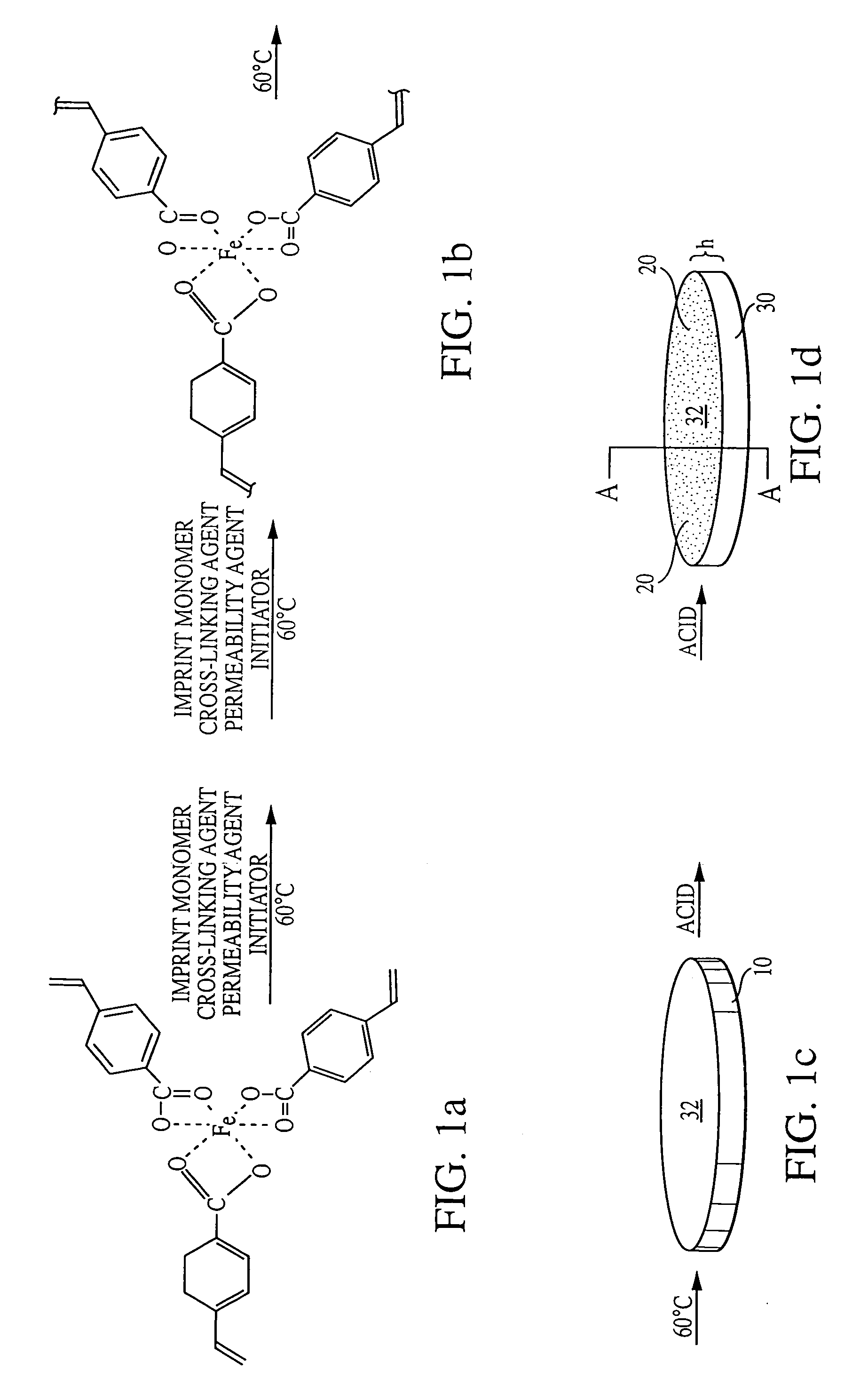Polymer based permeable membrane for removal of ions
a permeable membrane and polymer technology, applied in the field of molecular imprinting materials, can solve the problems of adversely affecting selectivity and activity, damage to sites, deformation of sites, etc., and achieve the effects of increasing permeability, increasing permeability, and increasing permeability
- Summary
- Abstract
- Description
- Claims
- Application Information
AI Technical Summary
Problems solved by technology
Method used
Image
Examples
example 2
[0061]Preparation of membranes using Ni (II) (bis-acrylamindophenanthroline)dinitrate imprinting complex.
[0062]Membrane synthesis was carried out in a screw-top vial by dissolving the Nickel (II) (bis-acrylamindophenanthroline)dinitrate complex (100 mg) in a solution consisting of 400 mL of nitrophenyl octyl ether as a plasticizer. Styrene was added to the solution as a matrix monomer, and divinylbenzene was added as a cross-linking monomer. Polyester (22 mg), prepared from diglycolic acid and 1,6-hexanediol, was added to the polymerization mixture. Because free radical polymerization is inhibited by the presence of oxygen, the mixture is normally purged with nitrogen. After deaeration with dry nitrogen, 20 mg of a free radical initiator, 2,2-azobisisobutyronitrile (AIBN) was added. The vial was sealed and placed in a sonicator at 60° C. Sonication is believed to help maintain homogeneity in the polymer. Zeng, X.; Murray, G. M. Separation Science and Technology, 31:2403-2418 (1996)....
example 3
[0064]Preparation of membranes using Ln (Lanthanide) (III)tris-(vinylbenzoylacetonate)(acrylamido-phenanthroline)phosphate.
[0065]Membrane synthesis was carried out in a screw-top vial by dissolving the Lanthanide (III)(vinylbenzoylacetonate)(acrylamidophenanthroline)biphosphate complex (100 mg) in a solution consisting of 400 mL of nitrophenyl octyl ether as a plasticizer. Styrene was added to the solution as a matrix monomer, and divinylbenzene was added as a cross-linking monomer. Polyester (22 mg), prepared from diglycolic acid and 1,6-hexanediol, was added to the polymerization mixture. After deaeration with dry nitrogen, 20 mg of a free radical initiator, 2,2-azobisisobutyronitrile (AIBN) was added. The vial was sealed and placed in a sonicator at 60° C. The polymerization mixture was sonicated until viscous. The viscous solution was poured into a TEFLON mold. The mold was kept in a sealed container and placed in an oven at 60° C. for 18 hours to complete the polymerization. Th...
example 4
[0067]Preparation of membranes using ferric vinylbenzoate, Fe(VBA)3.
[0068]Membrane synthesis was carried out in a screw-top vial by dissolving the iron vinylbenzoate complex (100 mg) in a solution consisting of 400 mL of nitrophenyl octyl ether as a plasticizer. Styrene was added to the solution as a matrix monomer, and divinylbenzene was added as a cross-linking monomer. Polyester (22 mg), prepared from diglycolic acid and 1,6-hexanediol was added to the polymerization mixture. After deaeration with dry nitrogen, 20 mg of a free radical initiator, 2,2-azobisisobutyronitrile (AIBN) was added. The vial was sealed and placed in a sonicator at 60° C. The polymerization mixture was sonicated until viscous. The viscous solution was poured into a TEFLON mold. The mold was kept in a sealed container and placed in an oven at 60° C. for 18 hours to complete the polymerization. The thickness of the resulting membranes was about 100 microns. The iron ions and the polyester were removed by usin...
PUM
| Property | Measurement | Unit |
|---|---|---|
| thickness | aaaaa | aaaaa |
| temperatures | aaaaa | aaaaa |
| permeability | aaaaa | aaaaa |
Abstract
Description
Claims
Application Information
 Login to View More
Login to View More - R&D
- Intellectual Property
- Life Sciences
- Materials
- Tech Scout
- Unparalleled Data Quality
- Higher Quality Content
- 60% Fewer Hallucinations
Browse by: Latest US Patents, China's latest patents, Technical Efficacy Thesaurus, Application Domain, Technology Topic, Popular Technical Reports.
© 2025 PatSnap. All rights reserved.Legal|Privacy policy|Modern Slavery Act Transparency Statement|Sitemap|About US| Contact US: help@patsnap.com



